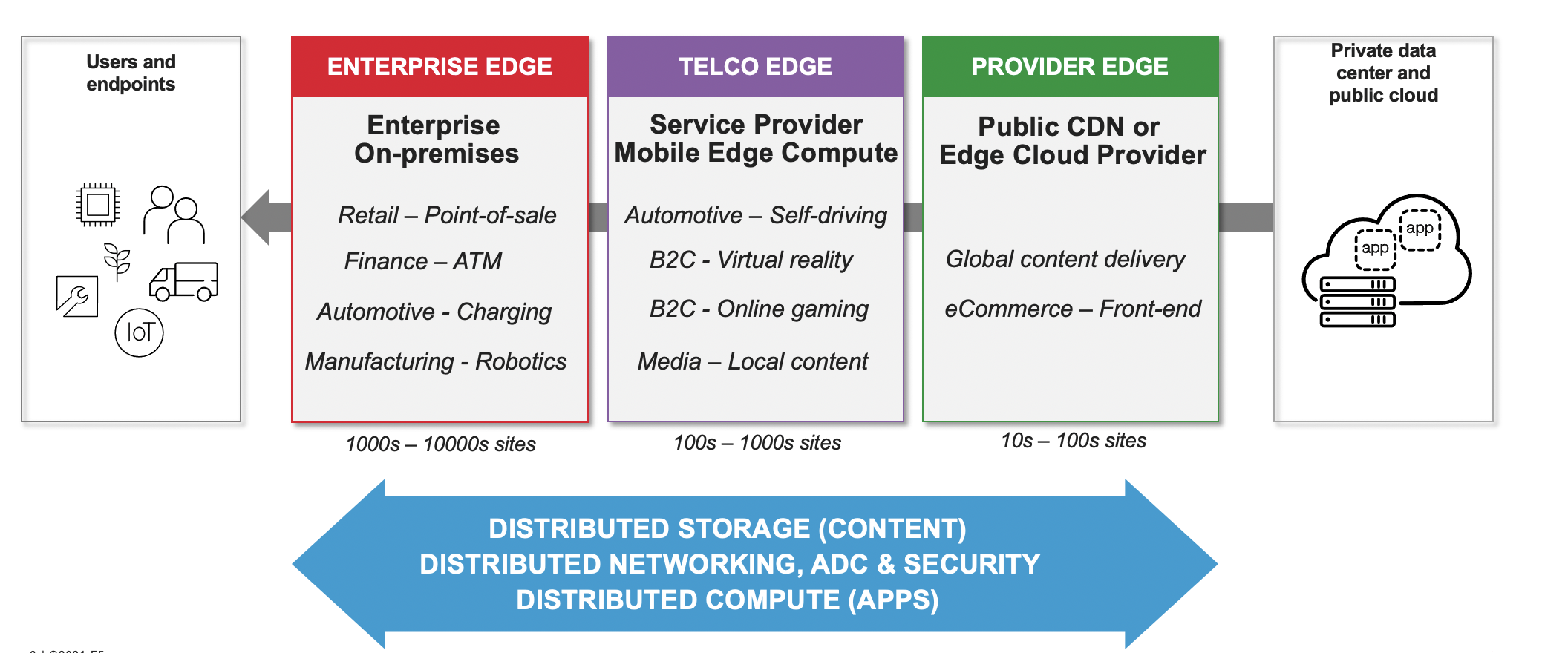Como as empresas de telecomunicações podem adotar a vantagem
À medida que a computação de ponta ganha força, oportunidades estão se abrindo para as empresas de telecomunicações. Já equipadas com recursos e recursos de ponta essenciais, as operadoras podem fornecer muito mais do que conectividade.
Empresas em toda a economia estão recorrendo à computação de ponta para dar suporte a aplicativos da “Indústria 4.0”, que precisam ser altamente confiáveis e altamente responsivos. Tais aplicações podem envolver o controle remoto de máquinas ou robôs, ou um sistema de pedidos automatizado em um restaurante de fast food ou rede de varejo.
As empresas de telecomunicações de hoje estão em condições de permitir que as empresas implantem e gerenciem aplicativos de forma rápida e segura em milhares de locais, tanto na ponta da empresa de telecomunicações quanto na ponta da empresa (conforme mostrado no gráfico abaixo). Para fazer isso, eles precisam aproveitar uma solução flexível e escalável que possa gerenciar aplicativos em nuvens públicas e privadas, bem como em data centers locais nos quais os recursos de computação podem ser limitados. Ao contrário dos data centers centralizados, muitas instalações de ponta ficarão em locais com restrições de espaço e precisarão ser enxutas e econômicas.
Ganhar uma vantagem competitiva
Embora muitos outros participantes também estejam mirando o mercado de ponta empresarial, as empresas de telecomunicações estão em uma posição particularmente forte. Eles já operam ativos físicos amplamente distribuídos, como estações base, escritórios centrais e até mesmo gabinetes no nível da rua, que podem fornecer as bases de uma rede de ponta. Ao combinar a computação de ponta com a conectividade necessária, é possível se tornar um balcão único e conveniente para empresas.
As empresas de telecomunicações também contam com valiosa experiência técnica e comercial. Eles entendem de redes e interfaces de rádio, enquanto a maioria das operadoras atende empresas em seus mercados locais há décadas. Ao mesmo tempo, eles têm um longo histórico na preservação da privacidade e na manutenção da segurança, ao mesmo tempo em que cumprem regulamentações rigorosas.
Hoje, a versatilidade e a confiabilidade do 5G estão permitindo que as empresas de telecomunicações subam na cadeia de valor e vão além de simplesmente oferecer redes de distribuição de conteúdo e serviços de cache. Isso representa uma oportunidade de desempenhar um papel fundamental na entrega de computação de ponta dinâmica e inteligente.
Além de fornecer conectividade rápida e responsiva, as operadoras podem usar o 5G para fornecer às empresas redes privadas, segurança privada e uma experiência de serviço gerenciada de ponta a ponta. Como parte dessa proposta mais ampla, agora é possível combinar redes de longa distância definidas por software com serviços de segurança, incluindo firewalls de aplicativos da web, medidas antibot, antiDoS e antifraude.
Configurando e controlando a computação de ponta
Além de rede e segurança, tecnologias nativas da nuvem, como microsserviços, contêineres e Kubernetes, são essenciais. Amplamente adotado no mundo da TI, o framework Kubernetes permite que os microsserviços constituintes de um aplicativo — compactados dentro de um contêiner — se movam dinamicamente para qualquer local de computação apropriado com uma pilha Kubernetes de suporte. Esse local pode ser uma nuvem pública, um servidor físico de propriedade da empresa ou uma máquina virtual no ponto de presença de uma empresa de telecomunicações.
Mas aproveitar o Kubernetes em uma arquitetura de ponta altamente distribuída pode ser complicado, principalmente porque há escassez de habilidades nessa área. Enquanto implantar um aplicativo em uma nuvem pública é simples, implantar um aplicativo em centenas ou milhares de locais e mantê-lo atualizado e seguro é uma proposta muito diferente. Isso exigiria ferramentas operacionais complexas. Na verdade, unir manualmente a lógica do aplicativo e as tecnologias de entrega e segurança nesses ambientes pode introduzir novos riscos de segurança e grande complexidade operacional.
Para complicar ainda mais as coisas, a vantagem significa coisas diferentes para pessoas diferentes. Para alguns fornecedores, a vantagem é limitada aos ambientes de computação específicos que eles oferecem suporte. Mas as empresas querem definir a vantagem para si mesmas e implantar seus aplicativos onde for mais conveniente. Eles também querem a flexibilidade de mover esses aplicativos, ou partes deles, de um ambiente para outro conforme seus negócios evoluem ou respondem à dinâmica do mercado.
Tornando rápido e simples
Para ajudar empresas de telecomunicações e empresas a enfrentar esses desafios, a F5 adquiriu a Volterra em janeiro de 2021 . Agora, a F5 tem uma plataforma que pode ser usada para implantar rapidamente e interconectar aplicativos com segurança em um número ilimitado de locais de ponta, independentemente de pertencerem a uma nuvem pública ou privada, ou estarem no local. À medida que a demanda por computação de ponta cresce, esse recurso tornará a vida muito mais fácil para muitas empresas de telecomunicações que atendem centenas, se não milhares, de clientes empresariais.
Além disso, como a Volterra usa tecnologia de contêiner padrão da indústria e Kubernetes, empresas e operadoras de telecomunicações podem "construir uma vez, implementar globalmente", em vez de reescrever o código para se adaptar às restrições de um provedor de ponta fechado. A tecnologia da Volterra também é o veículo ideal para implantar o pacote de segurança e entrega de aplicativos de nível empresarial da F5 em locais de ponta.
Como exemplo, a tecnologia Volterra da F5 poderia, por exemplo, permitir que uma empresa de telecomunicações implementasse e configurasse aplicativos em centenas, ou mesmo milhares, de lojas em nome de um varejista. Aqui, o console Volterra pode ser usado para implantar o front-end do aplicativo nas lojas. As empresas de telecomunicações poderiam então implementar o back-end da aplicação nos centros de dados privados do retalhista. A empresa de telecomunicações pode então fornecer serviços de aplicativo, como balanceamento de carga, firewall de aplicativo web, DDoS e segurança de API. A etapa final é dar ao varejista visibilidade de ponta a ponta sobre o desempenho do aplicativo e o status de segurança de todas as lojas. Isso poderia implicar que a empresa de telecomunicações fornecesse um portal de autoatendimento por meio do qual o varejista pode gerenciar a solução.
É uma abordagem elegante, simples e rápida. Além de permitir que as empresas de telecomunicações implantem aplicativos facilmente na borda, a solução F5-Volterra interconecta com segurança essa borda com servidores de dados centrais ou a nuvem pública por meio de túneis IPSec ou SSL. A interconexão de todos os sites é obtida por meio do backbone global privado de alta capacidade da Volterra, que está presente em mais de 20 PoPs em todo o mundo com várias conexões de trânsito de nível 1 e peering privado com os principais provedores de SaaS e nuvem pública.
Diferentemente de outras soluções no mercado que se originam do modelo de nuvem centralizada, a plataforma Volterra é leve e ocupa pouco espaço. Como a implantação e a configuração são quase sem esforço, empregar a solução F5-Volterra será muito mais econômico do que tentar construí-la internamente ou trabalhar com soluções mais rígidas e com uso intensivo de computadores fornecidas pelos hiperescaladores.
Construindo uma nuvem de telecomunicações
Se as empresas de telecomunicações puderem integrar a computação de ponta em sua infraestrutura existente de uma forma simples e contínua para seus clientes empresariais, elas poderão abrir novos e importantes fluxos de receita. Nos próximos cinco anos, os analistas esperam que o mercado de computação de ponta cresça rapidamente com a implantação de sensores industriais e de cidades inteligentes, sistemas avançados de controle de qualidade de manufatura, maquinário pesado controlado remotamente e veículos de frota autônomos. Até 2025 e depois, as plataformas de ponta poderão até servir como base para tecnologia totalmente autônoma, incluindo veículos autônomos, cirurgia remota e robôs industriais, de acordo com previsões do Boston Consulting Group. À medida que suas redes 5G se expandem, agora, mais do que nunca, é o momento para as empresas de telecomunicações desenvolverem uma proposta de ponta atraente.

